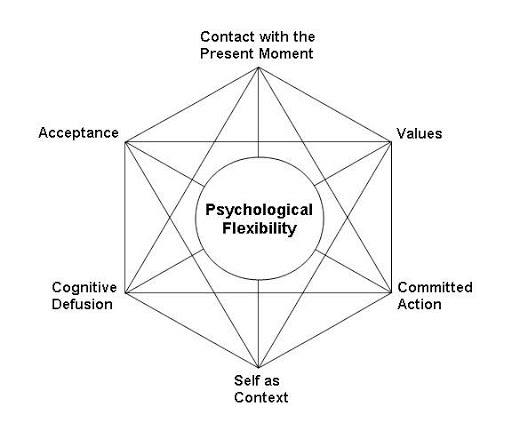
Two or more schools of psychotherapy may be integrated or synthesized in various ways. Singular yet similar psychotherapeutic schools may join with each other in terms of theory, technique, and or underlying change factors.1
In part one of this two-part series, the theoretical integration of Psilocybin Assisted Psychotherapy (PcbAP) and Acceptance and Commitment Therapy (ACT) was explored, as laid out in the Yale Manual for Psilocybin-Assisted Therapy of Depression (the Yale Manual).2 Beyond the natural theoretical integration of PcbAP and ACT, the Yale Manual also proposes a technical psychotherapeutic synergism, with psilocybin positioned as a catalyst of ACT-based psychotherapeutic processes.2,3
What is Psychotherapy Technique?
The term psychotherapy technique refers to the interventions and activities characteristic of practitioners of a particular school of psychotherapy.1 Often, there exist commonalities in therapeutic technique across two or more psychotherapies. In the case of PcbAP and ACT, the technical overlap may create a synergy whereby the long-lasting benefit of PcbAP for depressive disorders can be increased by integrating ACT principles and interventions into the course of PcbAP.3
The Technique and Structure of PcbAP
The PcbAP treatment course includes the therapeutic use of the potent psychoactive substance, psilocybin, in a limited number of sessions. Within the PcbAP framework, the administration of psilocybin is not viewed as a stand-alone intervention, although it may yield pharmacological effects as such.3 Rather, the Yale Manual suggests that the maximal clinical benefit of psilocybin is fully realized when administered within a psychotherapeutic framework. The standard framework for PcbAP encompasses three stages.
The three stages of PcbAP include preparation sessions, medication sessions, and integration sessions. Preparatory sessions set the stage for the administration of psilocybin and follow-up sessions are aimed at integrating the therapeutic benefit of the psychedelic sessions while shoring up treatment gains. In composing the Yale Manual, the authors conserved the preparation, medication, and integration framework used in other psychedelic therapy protocols, while integrating ACT technique–perspectives, principles, and interventions–into these stages and sessions in various ways.3
The Technical Overlap: Integrating ACT Technique into the PcbAP Course of Therapy
ACT is a unique evidence-based psychotherapy that lends itself to technical integration with the typical PcbAP structure; that is, ACT interventions and principles can be employed by a therapist within preparation sessions, medication sessions, and integration sessions. Within this PcbAP structure, the ACT technique is integrated through ACT-based clinical formulation, ACT-based clinical intervention, ACT-based didactic explanation, and ACT-based experiential exercises.3
ACT in PcbAP Preparation Sessions
Within preparation sessions, ACT-based interventions are aimed at not only building a therapeutic alliance, the bedrock of effective psychotherapy but also conducting a thorough psychological evaluation to facilitate an ACT-based clinical formulation.3 To arrive at such a clinical formulation, the therapist evaluates the client’s current functioning through the ACT therapeutic framework of psychological flexibility.3,4 Psychological flexibility is the overarching goal of ACT and refers to the capacity to accept internal and external discomfort, openly and willingly.4 Therefore, in preparatory sessions, therapists build their ACT-based clinical formulation by evaluating a client’s history of depression, noting instances of psychological inflexibility–for example, a tendency toward experiential avoidance.
Therapists also use ACT specific assessments, such as the Valued Living Questionnaire.3,5 In so doing, the ACT-PcbAP therapist can identify treatment targets on the ACT Hexaflex (Figure 1). After identifying targets for treatment, ACT-PcbAP therapists directly teach clients about ACT principles and philosophy via ACT-based didactic explanation.

Figure 1: Hexafle diagram illustrating the theoretical underpinnings of Acceptance and Commitment Therapy.5
ACT in PcbAP Medication Sessions
During ACT medication sessions, therapists work primarily as supportive guides, yet continue to build their ACT-based clinical formulations by listening to client reported themes, narratives, and insights evoked during the psilocybin experience.3 In addition, ACT therapists continue to identify and clarify treatment targets, paying particular attention to client reports of experiential avoidance, self-as-context, e.g. transcendent experiences, and present moment awareness (Figure 1).
ACT in PcbAP Integration Sessions
During integration sessions, ACT therapists work with clients to translate the therapeutic insights of psychedelic sessions into concrete emotional and behavioral change.3 For example, therapists may highlight narratives, themes, and insights that emerged during medication sessions, noting instances of psychological flexibility and inflexibility.2,3 Or therapists may use the ACT Hexaflex in session while exploring with clients when and how the psilocybin experience brought ACT processes to awareness.
Other more direct interventions may also be used. For example, mindfulness exercises may be introduced and the therapist may work with clients through ACT-specific metaphor to synthesize the psilocybin experience and bring about lasting change.2,3 In particular, insights obtained during the psilocybin experience around personal values become particularly salient, and therapists may work to help clients take committed action and begin living in accordance with their values.
Conclusion: The Integration of ACT and PcbAP
This two-part series explored the theoretical and technical integration of ACT and PcbAP as outlined in the Yale Manual for Psilocybin-Assisted Therapy of Depression. The Yale Manual was constructed to provide a therapeutic framework to facilitate the integration of PcbAP and ACT in the clinical and research setting, and to underscore the technical and theoretical synergy between the two. The PcbAP and ACT approach is innovative and synergistic, as both promote psychological flexibility, perhaps especially so, when integrated into a unified therapeutic protocol.
While combining antidepressant medication and evidence-based psychotherapy is a common practice in the treatment of depression, the two treatments typically follow independent treatment courses. In contrast, the Yale Manual provides an innovative and integrative protocol for medication-assisted psychotherapy, where psychotherapy works to synergistically amplify and optimize the therapeutic benefit of the psilocybin experience. As researchers continue to lay the empirical foundation for the clinical integration of PcbAP and ACT, many clinicians and clients are eagerly awaiting the wide-spread availability of this novel therapeutic approach as a promising treatment for depression.
